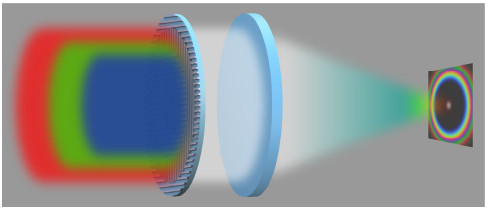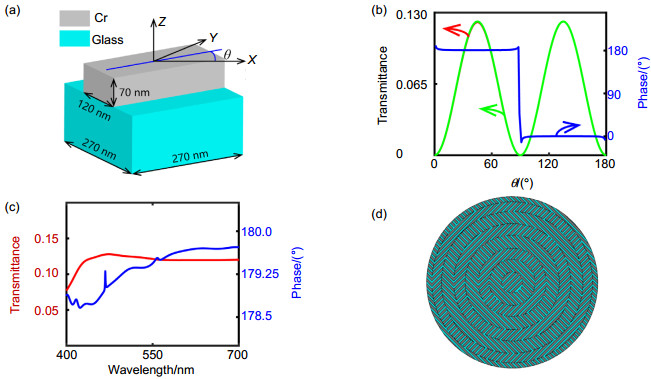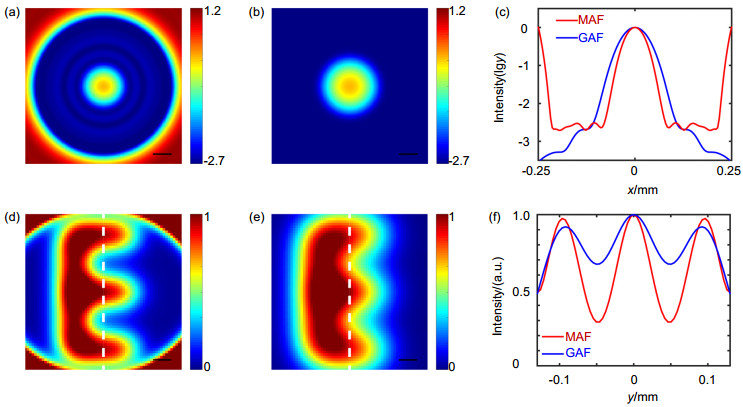| Citation: | Li Z, Wang C T, Kong W J, et al. Broadband achromatic metasurface filter for apodization imaging in the visible[J]. Opto-Electron Eng, 2021, 48(5): 200466. doi: 10.12086/oee.2021.200466 |
Broadband achromatic metasurface filter for apodization imaging in the visible
-
Abstract
Apodization has found many important applications in imaging and optical communication. Traditional apodization methods are based on the phase or amplitude modulation, suffering from either narrow working bandwidth, or reduced spatial resolution. Here, a broadband achromatic metasurface filter is proposed to realize apodization imaging without sacrificing the spatial resolution. With this filter, a nearly dispersionless phase modulation in the entire visible waveband can be achieved. The simulated results indicate that the focusing efficiency of the metasurface filter is twice larger than that of the phase filter and the imaging contrast can be improved by three times with the metasurface filter compared to the Gaussian filter. The sidelobes in the point spread function can also be efficiently suppressed to the scale of 10-5 in the whole visible spectrum ranging from 400 nm to 700 nm with our design. Additionally, the resolution of diffraction limit or even sub-diffraction can be achieved with this method.-
Keywords:
- apodization /
- broadband /
- dispersionless /
- metasurface
-

-
References
[1] Goodman J W. Introduction to Fourier Optics[M]. San Francisco: McGraw-Hill, 1968. [2] Watson S M, Mills J P, Gaiser S L, et al. Direct imaging of nonsolar planets with infrared telescopes using apodized coronagraphs[J]. Appl Opt, 1991, 30(22): 3253–3262. doi: 10.1364/AO.30.003253 [3] Xu X J, Narayanan R M. Enhanced resolution in SAR/ISAR imaging using iterative sidelobe apodization[J]. IEEE Trans Image Process, 2005, 14(4): 537–547. doi: 10.1109/TIP.2004.841198 [4] Kunath W, Zemlin F, Weiss K. Apodization in phase-contrast electron microscopy realized with hollow-cone illumination[J]. Ultramicroscopy, 1985, 16(2): 123–138. doi: 10.1016/0304-3991(85)90068-3 [5] Kasdin N J, Vanderbei R J, Spergel D N, et al. Extrasolar planet finding via optimal apodized-pupil and shaped-pupil coronagraphs[J]. Astrophys J, 2003, 582(2): 1147–1161. doi: 10.1086/344751 [6] Cheng R, Chrostowski L. Apodization of silicon integrated Bragg gratings through periodic phase modulation[J]. IEEE J Sel Top Quantum Electron, 2020, 26(2): 8300315. [7] Slepian D. Analytic solution of two apodization problems[J]. J Opt Soc Am, 1965, 55(9): 1110–1115. doi: 10.1364/JOSA.55.001110 [8] Carlotti A, Vanderbei R, Kasdin N J. Optimal pupil apodizations of arbitrary apertures for high-contrast imaging[J]. Opt Express, 2011, 19(27): 26796–26809. doi: 10.1364/OE.19.026796 [9] Kenworthy M A, Codona J L, Hinz P M, et al. First on-sky high-contrast imaging with an apodizing phase plate[J]. Astrophys J, 2007, 660(1): 762–769. doi: 10.1086/513596 [10] Guyon O. Phase-induced amplitude apodization of telescope pupils for extrasolar terrestrial planet imaging[J]. Astron Astrophys, 2003, 404(1): 379–387. doi: 10.1051/0004-6361:20030457 [11] Luo X G. Subwavelength optical engineering with metasurface waves[J]. Adv Opt Mater, 2018, 6(7): 1701201. doi: 10.1002/adom.201701201 [12] Pu M B, Li X, Guo Y H, et al. Nanoapertures with ordered rotations: symmetry transformation and wide-angle flat lensing[J]. Opt Express, 2017, 25(25): 31471–31477. doi: 10.1364/OE.25.031471 [13] Zhang F, Pu M B, Li X, et al. Extreme-angle silicon infrared optics enabled by streamlined surfaces[J]. Adv Mater, 2021, 33(11): 2008157. doi: 10.1002/adma.202008157 [14] 张飞, 郭迎辉, 蒲明博, 等. 基于非对称光子自旋—轨道相互作用的超构表面[J]. 光电工程, 2020, 47(10): 200366. doi: 10.12086/oee.2020.200366 Zhang F, Guo Y H, Pu M B, et al. Metasurfaces enabled by asymmetric photonic spin-orbit interactions[J]. Opto-Electron Eng, 2020, 47(10): 200366. doi: 10.12086/oee.2020.200366 [15] 崔建华, 马晓亮, 蒲明博, 等. 弱手性超表面中的超常极化旋转[J]. 光电工程, 2020, 47(7): 190052. doi: 10.12086/oee.2020.190052 Cui J H, Ma X L, Pu M B, et al. Extraordinary strong optical rotation in weak chiral metasurface[J]. Opto-Electron Eng, 2020, 47(7): 190052. doi: 10.12086/oee.2020.190052 [16] 代成伟, 闫超, 曾庆玉, 等. 一种新型贝塞尔光束器件的设计方法[J]. 光电工程, 2020, 47(6): 190190. doi: 10.12086/oee.2020.190190 Dai C W, Yan C, Zeng Q Y, et al. A method of designing new Bessel beam generator[J]. Opto-Electron Eng, 2020, 47(6): 190190. doi: 10.12086/oee.2020.190190 [17] Naserpour M, Zapata-Rodríguez C J, Díaz-Aviñó C, et al. Ultrathin high-index metasurfaces for shaping focused beams[J]. Appl Opt, 2015, 54(25): 7586–7591. doi: 10.1364/AO.54.007586 [18] Hashemi M, Moazami A, Naserpour M, et al. Amplitude modulation technique for designing metalenses with apodized and enhanced resolution focal spots[J]. Opt Commun, 2017, 393: 77–82. doi: 10.1016/j.optcom.2017.02.032 [19] Ma X L, Pu M B, Li X, et al. All-metallic wide-angle metasurfaces for multifunctional polarization manipulation[J]. Opto-Electron Adv, 2019, 2(3): 180023. [20] Dou K H, Xie X, Pu M B, et al. Off-axis multi-wavelength dispersion controlling metalens for multi-color imaging[J]. Opto-Electron Adv, 2020, 3(4): 190005. [21] Jin J J, Pu M B, Wang Y Q, et al. Multi-channel vortex beam generation by simultaneous amplitude and phase modulation with two-dimensional metamaterial[J]. Adv Mater Technol, 2017, 2(2): 1600201. doi: 10.1002/admt.201600201 [22] Berry M V. The adiabatic phase and pancharatnam's phase for polarized light[J]. J Mod Opt, 1987, 34(11): 1401–1407. doi: 10.1080/09500348714551321 [23] Chen X Z, Huang L L, Mühlenbernd H, et al. Dual-polarity plasmonic metalens for visible light[J]. Nat Commun, 2012, 3: 1198. doi: 10.1038/ncomms2207 [24] Luo X G, Pu M B, Li X, et al. Broadband spin Hall effect of light in single nanoapertures[J]. Light: Sci Appl, 2017, 6(6): e16276. doi: 10.1038/lsa.2016.276 [25] Hasman E, Kleiner V, Biener G, et al. Polarization dependent focusing lens by use of quantized Pancharatnam–Berry phase diffractive optics[J]. Appl Phys Lett, 2003, 82(3): 328–330. doi: 10.1063/1.1539300 [26] Li X, Chen L W, Li Y, et al. Multicolor 3D meta-holography by broadband plasmonic modulation[J]. Sci Adv, 2016, 2(11): e1601102. doi: 10.1126/sciadv.1601102 [27] Liu H T, Yan Y B, Tan Q F, et al. Theories for the design of diffractive superresolution elements and limits of optical superresolution[J]. J Opt Soc Am A, 2002, 19(11): 2185–2193. doi: 10.1364/JOSAA.19.002185 [28] Jin N B, Rahmat-Samii Y. Advances in particle swarm optimization for antenna designs: real-number, binary, single-objective and multiobjective implementations[J]. IEEE Trans Antennas Propag, 2007, 55(3): 556–567. doi: 10.1109/TAP.2007.891552 [29] Zheng G X, Mühlenbernd H, Kenney M, et al. Metasurface holograms reaching 80% efficiency[J]. Nat Nanotech, 2015, 10(4): 308–312. doi: 10.1038/nnano.2015.2 -
Overview
Overview: Apodization is an effective way to relieve the influence of sidelobes in the point spread function of an imaging system, and has found many significant applications in imaging and optical communication, such as the coronagraphs in astronomical field and spectral tailoring in silicon integrated Bragg grating devices. Traditional apodization methods are based on the phase or amplitude modulation. By introducing mask with specially designed transmittance or diffractive optical element to the pupil plane of an imaging system, the sidelobes in the diffraction pattern are well suppressed so that weak details can be distinguished. However, these methods suffer from either narrow working bandwidth or reduced spatial resolution. Recently, as one kind of artificially structured materials, the metasurfaces have drawn much attention because they can manipulate light field at the subwavelength scale. Among them, the metasurface based on the geometric phase principle has been applied in achromatic imaging, broadband hologram, orbit angular momentum beam, and so on, which provides a new approach to modulate the electromagnetic field flexibly in a broadband spectrum. Benefiting from the broadband dispersionless phase modulation, the metasurface also brings another access for apodization imaging. In this paper, a metasurface apodization filter is proposed to realize broadband achromatic apodization imaging. With this filter, the nearly dispersionless phase modulation in the entire visible waveband can be achieved. The simulated results indicate that, compared to phase apodization filter, the working bandwidth can be improved from 10 nm to 300 nm with metasurface apodization filter. Moreover, the focusing efficiency of metasurface apodization filter is twice larger than that of the phase apodization filter. The sidelobes in the point spread function can be efficiently suppressed to the scale of 10-5 with our design, which helps to resolving point-objects with large intensity contrast. Additionally, the resolution of diffraction limit or even sub-diffraction can be achieved with increased imaging contrast by using this method compared to traditional Gaussian apodization filter. The metasurface apodization filter offers a promising alternative for apodization imaging and potentially promotes further developments in the field like astronomical observation, spectrum detection, and optical communication.
-
Access History

Article Metrics
- Figure 1.
- Figure 2.
- Figure 3.
- Figure 4.
- Figure 5.

 E-mail Alert
E-mail Alert RSS
RSS



 DownLoad:
DownLoad:






